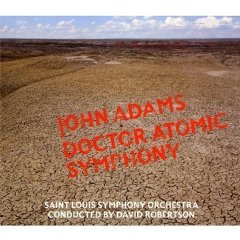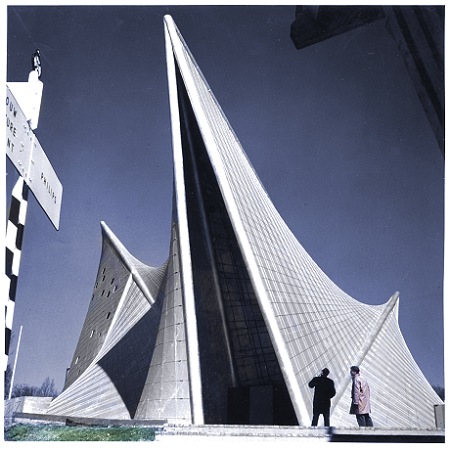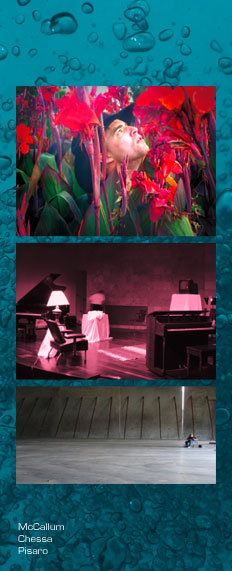Head’s up on a couple things this coming week that caught my eye:
 WPRB’s Marvin Rosen is doing a special edition of his Classical Discoveries radio show this Wednesday, Jan. 27th. From 5:30 until 11:00 AM EST. Titled “East Meets West“, the entire five-and-a-half hours will be devoted to works by Middle and Far Eastern Composers, as well as to works by Western composers inspired by these regions. A special treat in the 10-o’clock hour will be the world premiere broadcast of the Sonata for solo viola Op. 423 (1992) by Alan Hovhaness (1911-2000), performed by Christina Fong (from a brand-new OgreOgress release). Then from 11AM until 1PM, Marvin’s guest will be composer/improviser/percussionist Lukas Ligeti. A swell time all around, and as always no matter where you are your computer can bring you the broadcast live.
WPRB’s Marvin Rosen is doing a special edition of his Classical Discoveries radio show this Wednesday, Jan. 27th. From 5:30 until 11:00 AM EST. Titled “East Meets West“, the entire five-and-a-half hours will be devoted to works by Middle and Far Eastern Composers, as well as to works by Western composers inspired by these regions. A special treat in the 10-o’clock hour will be the world premiere broadcast of the Sonata for solo viola Op. 423 (1992) by Alan Hovhaness (1911-2000), performed by Christina Fong (from a brand-new OgreOgress release). Then from 11AM until 1PM, Marvin’s guest will be composer/improviser/percussionist Lukas Ligeti. A swell time all around, and as always no matter where you are your computer can bring you the broadcast live.
 If you happen to be on the other coast that same day (Jan. 27th), you’re in for a treat if you head to the Pasadena Central Library (Donald R. Wright Auditorium, 285 E. Walnut St.) at 6PM PST, for a concert presented by Cellogrill (über-cellist Jessica Catron) and the Pasadena Creative Music Series. The concert opens with the world premiere of composer Cat Lamb’s Branches for just-intoned female choir assembled especially for this occasion. Next up, MISSINCINATTI follows with folk songs of land and sea; forgotten tales about fantastical crocodiles, maritime ghosts and work in the mines illuminated before your very eyes with the assistance of many special musical guests. And finally, the compositions of RATS can confound and delight like a musical retelling of The Wizard of Oz by Captain Beefheart. And all this for the princely sum of FREE.
If you happen to be on the other coast that same day (Jan. 27th), you’re in for a treat if you head to the Pasadena Central Library (Donald R. Wright Auditorium, 285 E. Walnut St.) at 6PM PST, for a concert presented by Cellogrill (über-cellist Jessica Catron) and the Pasadena Creative Music Series. The concert opens with the world premiere of composer Cat Lamb’s Branches for just-intoned female choir assembled especially for this occasion. Next up, MISSINCINATTI follows with folk songs of land and sea; forgotten tales about fantastical crocodiles, maritime ghosts and work in the mines illuminated before your very eyes with the assistance of many special musical guests. And finally, the compositions of RATS can confound and delight like a musical retelling of The Wizard of Oz by Captain Beefheart. And all this for the princely sum of FREE.

 The tremendously devastating earthquake in Haiti has brought forth a wonderful outpouring of donations from all corners, to a lot of fine organizations dedicated to helping these folk through the weeks and months ahead. Sometimes though, it takes a little extra prod to dislodge those few more dollars that, while so small here, can make an enormous difference in the survivor’s well-being.
The tremendously devastating earthquake in Haiti has brought forth a wonderful outpouring of donations from all corners, to a lot of fine organizations dedicated to helping these folk through the weeks and months ahead. Sometimes though, it takes a little extra prod to dislodge those few more dollars that, while so small here, can make an enormous difference in the survivor’s well-being.


 Thrown almost at once into the hotbed of post-WWII modern music, surrounded by the likes of Karlheinz Stockhausen, Pierre Boulez, Jean Barraqué, and Pierre Schaeffer, yet still working for Le Corbusier, Xenakis soon found ways to integrate his love of mathematics and architecture with new musical forms based on points and masses, curves and densities, later even physics and statistics — but somehow always tied to a deeply Greek historical and humanistic root system. During this transformative period, he stumbled upon a fascinating discussion about
Thrown almost at once into the hotbed of post-WWII modern music, surrounded by the likes of Karlheinz Stockhausen, Pierre Boulez, Jean Barraqué, and Pierre Schaeffer, yet still working for Le Corbusier, Xenakis soon found ways to integrate his love of mathematics and architecture with new musical forms based on points and masses, curves and densities, later even physics and statistics — but somehow always tied to a deeply Greek historical and humanistic root system. During this transformative period, he stumbled upon a fascinating discussion about 
